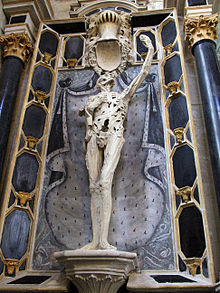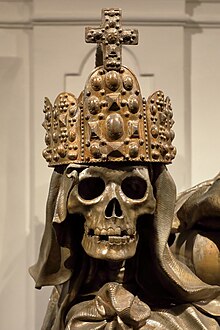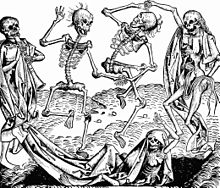Macabre





Inworks of art,the adjectivemacabre(US:/məˈkɑːb/orUK:/məˈkɑːbrə/;French:[makabʁ]) means "having the quality of having a grim orghastlyatmosphere ". The macabre works to emphasize the details and symbols ofdeath.The term also refers to works particularly gruesome in nature.
History
[edit]Early traces of macabre can be found inAncient GreekandLatinwriters such as the Roman writerPetronius,author of theSatyricon(late 1st century CE), and the Numidian writerApuleius,author ofThe Golden Ass(late 2nd century CE). Outstanding instances of macabre themes inEnglish literatureinclude the works ofJohn Webster,Robert Louis Stevenson,Mervyn Peake,Charles Dickens,Roald Dahl,Thomas Hardy,andCyril Tourneur.[3]InAmerican literature,authors whose work feature this quality includeEdgar Allan Poe,H. P. Lovecraft,andStephen King.The word has gained its significance from its use in French asla danse macabrefor theallegoricalrepresentation of the ever-present and universal power of death, known in German asTotentanzand later in English as theDance of the Dead.The typical form which the allegory takes is that of a series of images in whichDeathappears, either as a dancingskeletonor as a shrunken shrouded corpse, to people representing every age and condition of life, and leads them all in a dance to thegrave.Of the numerous examples painted or sculptured on the walls of cloisters or church yards throughmedieval Europe,few remain except inwoodcutsandengravings.
- The series atBaseloriginally at theKlingenthal,a nunnery in Little Basel, dated from the beginning of the 14th century. In the middle of the 15th century this was moved to the churchyard of the Predigerkloster at Basel, and was restored, probably by Hans Kluber, in 1568. The collapse of the wall in 1805 reduced it to fragments, and only drawings of it remain.
- ADance of the Deadin its simplest form still survives in theMarienkircheatLübeckas 15th-century painting on the walls of a chapel. Here there are 24 figures in couples, between each is a dancing Death linking the groups by outstretched hands, the whole ring being led by a Death playing on a pipe.
- InTallinn(Reval), Estonia there is a well-knownDanse Macabrepainting byBernt Notkedisplayed atSt. Nikolaus Church (Niguliste),dating the end of 15th century.
- AtDresdenthere is a sculptured life-size series in the old Neustädter Kirchhoff, moved here from the palace of Duke George in 1701 after a fire.
- AtRouenin the cloister of St Maclou there also remains a sculptureddanse macabre.
- There was a celebrated fresco of the subject in the cloister ofOld St PaulsinLondon.
- There was another in the now destroyed Hungerford Chapel atSalisbury,of which only a single woodcut, "Death and the Gallant", remains.
- Of the many engraved reproductions of the Old St Pauls fresco, the most famous is the series drawn byHolbein.
The theme continued to inspire artists and musicians long after the medieval period,Schubert'sstring quartetDeath and the Maiden(1824) being one example, andCamille Saint-Saëns' tone poemDanse macabre, op. 40(1847).
In the 20th century,Ingmar Bergman's 1957 filmThe Seventh Sealhas a personified Death, and could thus count as macabre.
The origin of this allegory in painting and sculpture is disputed. It occurs as early as the 14th century, and has often been attributed to the overpowering consciousness of the presence of death due to theBlack Deathand the miseries of theHundred Years' War.It has also been attributed to a form of theMorality,a dramatic dialogue between Death and his victims in every station of life, ending in a dance off the stage.[4]The origin of the peculiar form the allegory has taken has also been found in the dancing skeletons on lateRoman sarcophagiand mural paintings atCumaeorPompeii,and a false connection has been traced with the frescoTrionfo della Morte( "Triumph of Death" ), painted by theItalian RenaissanceartistBuonamico Buffalmacco(c. 1330s–1350,disputed),[2]and currently preserved in theCampo SantoofPisa.[1]
Etymology
[edit]Theetymologyof the word "macabre" is uncertain. According toGaston Paris,French scholar ofRomance studies,it first occurs in the form "macabree" in a poem,Respit de la mort(1376), written by the medieval Burgundian chroniclerJean Le Fèvre de Saint-Remy:[5]
Je fis de Macabree la dance,
Qui toute gent maine a sa trace
Et a la fosse les adresse.[5]
The more usual explanation is based on the Latin name,Machabaeorum chorea( "Dance of theMaccabees"). The seven tortured brothers, with theirmotherandEleazar(2 Maccabees6 and 7) are prominent figures in the dramatic dialogues.[6]Other connections have been suggested, as for example withSt. Macarius the Great,an Egyptian Coptic monk and hermit who is to be identified with the figure pointing to the decaying corpses in the frescoTrionfo della Morte( "Triumph of Death" ) painted by theItalian RenaissanceartistBuonamico Buffalmacco,according to the Italian art historianGiorgio Vasari;[citation needed]or with theArabicwordmaqābir(مقابر, plural ofmaqbara) which means "cemeteries".[citation needed]A related suggestion has been made that the word originates in Hebrewmqbrmeaning "from the grave".
See also
[edit]- Body horror
- Black Death in medieval culture
- Danse Macabre,medieval allegory on the universality of death
- Danse macabre,tone poem written in 1874 byCamille Saint-Saëns
- Grimdark
- Horror fiction
- Memento mori,symbolic trope acting as a reminder of the inevitability of death
References
[edit]- ^abBellosi, Luciano (2000).Come un prato fiorito. Studi sull'arte tardogotica.Di fronte e attraverso. Storia dell'arte (in Italian).Milan:Jaca Book. p. 9.ISBN9788816404335.
- ^abAavitsland, Kristin B. (2012)."Mortis Memoria:To Remember One's Death ".Imagining the Human Condition in Medieval Rome: The Cistercian fresco cycle at Abbazia delle Tre Fontane.Routledge (1st ed.).LondonandNew York:Routledge.pp. 131–132.ISBN9781138273078.LCCN2011050166.
- ^"Roald Dahl Day: From Tales of the Unexpected to Switch Bitch, Dahl's undervalued stories for adults".The Independent.14 October 2017.
- ^SeeDu Cange,Gloss., s.v. Machabaeorum chora.
- ^abParis, Gaston(1895). Meyer, Paul; Paris, Gaston (eds.)."La Dance Macabréde Jean Le Fèvre ".Romania(in French).24(93).Paris:Librairie Droz, on behalf of the Société des amis de la Romania: 129–132.doi:10.3406/roma.1895.5871.eISSN2391-1018.ISSN0035-8029.JSTOR45042550.Retrieved21 September2022.
- ^TheShorter Oxford English Dictionary(Fifth edition; 2002) states that the origin of "macabre" perhaps has reference to "a miracle play containing the slaughter of the Maccabees." Volume 1, p. 1659.
